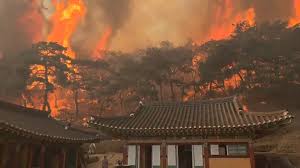
South Korea is grappling with its deadliest and most destructive wildfire on record, which has claimed 27 lives and forced tens of thousands to evacuate, officials said on Thursday. The fires, which erupted over the weekend, have scorched vast areas in the country’s southeast, cutting off roads, downing communication lines, and leaving many residents fleeing in panic.
According to the Ministry of Interior and Safety, 27 people have died, including three firefighters and a helicopter pilot, with officials warning that the toll could rise further. More than 35,000 hectares (86,500 acres) of forest have been consumed by the inferno, surpassing the country’s previous largest wildfire in April 2000, which burned 23,913 hectares.
Wind, Dry Weather Fuel Unprecedented Blaze
Authorities said strong winds and unusually dry conditions have made traditional firefighting methods less effective. The affected region had received only half its average rainfall in recent months, creating the perfect conditions for wildfires to spread rapidly.
“This wildfire has once again exposed the harsh reality of a climate crisis unlike anything we’ve experienced before,” said Lee Han-kyung, South Korea’s disaster and safety division chief. He warned that the changing climate, coupled with a lack of rainfall and strong winds, had intensified the blaze.
South Korea’s Meteorological Administration noted that while recent temperatures have been in line with the country’s 30-year average, last year was the hottest on record. Experts suggest that climate change may have contributed to the disaster, although poor forest management practices—such as prioritizing flammable pine trees over a natural mix of deciduous trees—may have also played a role.
Cultural Heritage Under Threat
The fires have also threatened South Korea’s historic and cultural landmarks. At Bongjeongsa temple in Andong, home to the country’s oldest wooden structure and a UNESCO-listed site, authorities made the difficult decision to cut down a 200-year-old pine tree to prevent the fire from reaching the temple.
“We had no choice but to cut it down… The fire is spreading rapidly from one pine tree to another,” said the temple’s chief monk.
Firefighters are also working tirelessly to protect Byeongsan Seowon, a former Confucian academy and UNESCO-listed site. “We are spraying three tonnes of water every day,” said Lee Seung-myung from the Andong fire department, while firefighter Choi Young-ho expressed concerns that strong winds could spread the flames further.
Hope for Relief as Rain Expected
With firefighters struggling to contain the blaze, authorities are hoping that rain forecasted for late Thursday will provide a crucial opportunity to extinguish the fires.
President Yoon Suk Yeol has vowed to provide support to those affected and ensure that such a disaster does not occur again. Meanwhile, officials have urged residents to remain cautious and follow evacuation orders as firefighting efforts continue.
As South Korea battles its largest wildfire on record, the disaster serves as a stark reminder of the increasing threat posed by extreme weather events and the urgent need for climate adaptation measures.
Sources By Agencies


